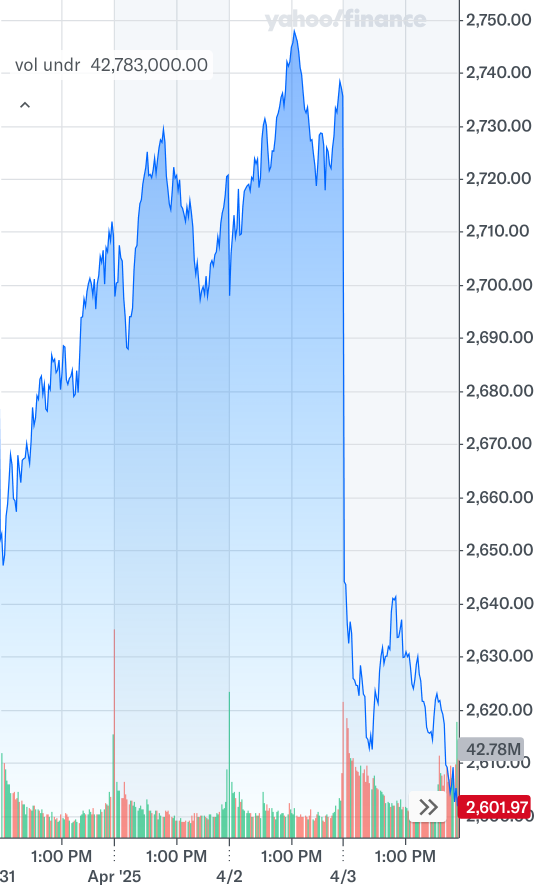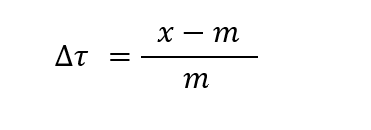Resembling a robot recession
EVERYONE is an expert on tariffs as we write. Maybe those at the centre of the storm are less so than we commentators, though. It looks at least plausible that they outsourced possibly the most momentous fiscal decision of the century so far to - you guessed? - a so-called “artificial intelligence”.

"A photorealistic image of an artificial intelligence giving advice in the Oval Office to a US President who has orange skin with his White House deputy chief of staff for policy, who is bald, standing by" as supplied by ChatGPT's DALL-E feature.The rendering of Stephen Miller seems... sanitised.

The S&P 100 index of top US shares' prices from 31 March to 4 April 2025
The first thing to leap out of US president Donald Trump's announcement on the evening of 2 April was that some geek had calculated tariffs - taxes on imports - for every territory in the ISO-3166 list of abbreviations, which you will have encountered through geographical internet domain codes.
Thus the penguins that are the most significant inhabitants of the Heard and McDonald Islands (.HM) woke up to the news that, were they to export to the US, their wares would sit on the dock until the recipient paid 10 per cent of their value to the US Treasury. Heaven forfend that these people should recognise a multilateral organisation such as the World Trade Organization, which knows a bit about who trades with whom.
Next was the impact on share prices - see graph - and thus on pension funds, for example.
Third was: where on Earth did they get those numbers from? Why was Lesotho hit with the heaviest charge, at 50 per cent?
Economist James Surowiecki Tweeted the formula at 22:22 GMT on 2 April. Calculate a territory's trade deficit with the US - its exports to the States minus its imports therefrom. Divide that by the import figure. Arbitrarily let x stand for exports and m for imports and you can write the raw tariff as x - m / m. Then convert to a percentage and halve it (as Trump said, “to be kind”), but set a minimum of 10 per cent, as is imposed on the penguins for lack of actual trade data.

Clever! Greek letters! Subscripts!
The White House responded (apparently at 01:06 GMT on 3 April) with a superficially detailed methodology. It included an equation with Greek letters and everything. But since they set the variables ε and φ to 4 and 0.25 respectively, they cancel out; and leaving out the subscripts - since we're dealing with just one country - we get exactly the formula that James Surowiecki deduced: see below. He later pointed out that it's even worse than he thought: the calculations include only trade in tangible goods, not services, which would include copyright licensing.

Nonsense algebra, simplified
Meanwhile. at 00:14 GMT on 3 April one Rohit Krishnan Tweeted that he had asked six “artificial intelligence” programs: “What would be an easy way to calculate the tariffs that should be imposed on other countries so that the US is on even-playing fields when it comes to trade deficit? Set minimum at 10%.”
All, including ChatGPT, came up with the same formula. One, Deepseek, did so only with some protest. Dominic Preston ran his own tests for The Verge and reported that Google's chatbot Gemini was sterner: “the real-world economic implications are far more complex and could lead to substantial negative consequences... many economists argue that tariffs are not an effective tool for balancing trade deficits.”
In Rohit's tests, though, two chatbots specifically recommended halving the figure they first “thought” of, as did the Trump administration.
Other people likely made the same connection; but Rohit, as author of Building God: Demystifying AI for Decision Makers, can't be accused of AIphobia.
This is of course not conclusive evidence that the White House used a chatbot to do its homework and wreak havoc. It is, so far, less of a smoking gun than the ChatGPT logs of Peter Kyle, UK Secretary of State for Science, Innovation and Technology.
Asked for a reference, ChatGPT points us to a 2017 paper by one Peter Navarro, appointed by Trump to the White House National Trade Council, titled Memo on Deficit Neutral Trade. We are suspicious that it may have confabulated this: we have tried hard and not yet found it. A chatbot called Claude refers us to Death by China by the same author. This exists: it is also possible that the chatbots were trained on it and regurgitated a Trumpian conclusion from it. As Rohit Krishnan puts it: “Data poisoning is real.”
In any case, actual human economists are united that this is all, in the words of Adam Tooze, an economic historian at Columbia University, “idiotic”.
 'Artificial Intelligence' our coverage to date
'Artificial Intelligence' our coverage to date
![[Freelance]](../gif/fl3H.png)